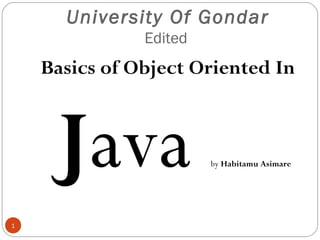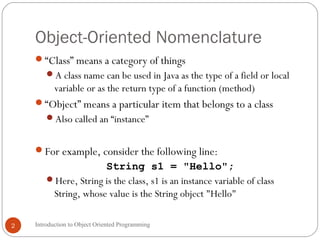Java basic understand OOP
- 1. University Of Gondar Edited 1 Basics of Object Oriented In Java by Habitamu Asimare
- 2. Object-Oriented Nomenclature Introduction to Object Oriented Programming2 ïâClassâ means a category of things ïA class name can be used in Java as the type of a field or local variable or as the return type of a function (method) ïâObjectâ means a particular item that belongs to a class ïAlso called an âinstanceâ ïFor example, consider the following line: String s1 = "Hello"; ïHere, String is the class, s1 is an instance variable of class String, whose value is the String object "Hello"
- 3. Example 1: Instance Variables (âFieldsâ or âData Membersâ) Introduction to Object Oriented Programming3 class Ship1 { public double x, y, speed, direction; public String name; } public class Test1 { public static void main(String[] args) { Ship1 s1 = new Ship1(); s1.x = 0.0; s1.y = 0.0; s1.speed = 1.0; s1.direction = 0.0; // East s1.name = "Ship1"; System.out.println(s1.name + " is initially at (" + s1.x + "," + s1.y + ")."); s1.x = s1.x + s1.speed * Math.cos(s1.direction * Math.PI / 180.0); s1.y = s1.y + s1.speed * Math.sin(s1.direction * Math.PI / 180.0); System.out.println(s1.name + " has moved to (" + s1.x + "," + s1.y + ")."); } }
- 4. Instance Variables: Results Introduction to Object Oriented Programming4 ïCompiling and Running: javac Test1.java java Test1 Output: Ship1 is initially at (1,0). Ship2 has moved to (-1.41421,1.41421).
- 5. Example 1: Major Points Introduction to Object Oriented Programming5 ïJava naming convention ïFormat of class definitions ïCreating classes with ânewâ ïAccessing fields with âvariableName.fieldNameâ
- 6. Java Naming Conventions Introduction to Object Oriented Programming6 ïLeading uppercase letter in class name public class MyClass { ... } ïLeading lowercase letter in field, local variable, and method (function) names ïmyField, myVar, myMethod
- 7. First Look at Java Classes Introduction to Object Oriented Programming7 ï The general form of a simple class is modifier class Classname { modifier data-type field1; modifier data-type field2; ... modifier data-type fieldN; modifier Return-Type methodName1(parameters) { //statements } ... modifier Return-Type methodName2(parameters) { //statements } }
- 8. Objects and References Introduction to Object Oriented Programming8 ïOnce a class is defined, you can easily declare a variable (object reference) of the class Ship s1, s2; Point start; Color blue; ïObject references are initially null ïThe null value is a distinct type in Java and should not be considered equal to zero ïA primitive data type cannot be cast to an object (use wrapper classes) ïThe new operator is required to explicitly create the object that is referenced ClassName variableName = new ClassName();
- 9. Accessing Instance Variables Introduction to Object Oriented Programming9 ïUse a dot between the variable name and the field name, as follows: variableName.fieldName ïFor example, Java has a built-in class called Point that has x and y fields Point p = new Point(2, 3); // Build a Point object int xSquared = p.x * p.x; // xSquared is 4 p.x = 7; ïOne major exception applies to the âaccess fields through varName.fieldNameâ rule ïMethods can access fields of current object without varName ïThis will be explained when methods (functions) are discussed
- 10. Example 2: Methods Introduction to Object Oriented Programming10 class Ship2 { public double x=0.0, y=0.0, speed=1.0, direction=0.0; public String name = "UnnamedShip"; private double degreesToRadians(double degrees) { return(degrees * Math.PI / 180.0); } public void move() { double angle = degreesToRadians(direction); x = x + speed * Math.cos(angle); y = y + speed * Math.sin(angle); } public void printLocation() { System.out.println(name + " is at (" + x + "," + y + ")."); } }
- 11. Methods (Continued) Introduction to Object Oriented Programming11 public class Test2 { public static void main(String[] args) { Ship2 s1 = new Ship2(); s1.name = "Ship1"; Ship2 s2 = new Ship2(); s2.direction = 135.0; // Northwest s2.speed = 2.0; s2.name = "Ship2"; s1.move(); s2.move(); s1.printLocation(); s2.printLocation(); } } ïCompiling and Running: javac Test2.java java Test2 ïOutput: Ship1 is at (1,0). Ship2 is at (-1.41421,1.41421).
- 12. Example 2: Major Points Introduction to Object Oriented Programming12 ïFormat of method definitions ïMethods that access local fields ïCalling methods ïStatic methods ïDefault values for fields ïpublic/private distinction
- 13. Defining Methods (Functions Inside Classes) Introduction to Object Oriented Programming13 ïBasic method declaration: public ReturnType methodName(type1 arg1, type2 arg2, ...) { ... return(something of ReturnType); } ïException to this format: if you declare the return type as void ïThis special syntax that means âthis method isnât going to return a value â it is just going to do some side effect like printing on the screenâ ïIn such a case you do not need (in fact, are not permitted), a return statement that includes a value to be returned
- 14. Examples of Defining Methods Introduction to Object Oriented Programming14 ïHere are two examples: ïThe first squares an integer ïThe second returns the faster of two Ship objects, assuming that a class called Ship has been defined that has a field named speed // Example function call: // int val = square(7); public int square(int x) { return(x*x); } // Example function call: // Ship faster = fasterShip(someShip, someOtherShip); public Ship fasterShip(Ship ship1, Ship ship2) { if (ship1.speed > ship2.speed) { return(ship1); } else { return(ship2); } }
- 15. Exception to the âField Access with Dotsâ Rule Introduction to Object Oriented Programming15 ïNormally access a field via: variableName.fieldName but an exception is when a method of a class wants to access fields of that same class ïIn that case, omit the variable name and the dot ïFor example, a move method within the Ship class might do: public void move() { x = x + speed * Math.cos(direction); ... } ïHere, x, speed, and direction are all fields within the class that the move method belongs to, so move can refer to the fields directly ïAs weâll see later, you still can use the variableName.fieldName approach, and Java invents a variable called this that can be used for that purpose
- 16. Static Methods Introduction to Object Oriented Programming16 ïStatic functions are like global functions in other languages ïYou can call a static method through the class name ClassName.functionName(arguments); ïFor example, the Math class has a static method called cos that expects a double precision number as an argument ïSo you can call Math.cos(3.5) without ever having any object (instance) of the Math class
- 17. Method Visibility Introduction to Object Oriented Programming17 ïpublic/private distinction ïA declaration of private means that âoutsideâ methods canât call it -- only methods within the same class can ïThus, for example, the main method of the Test2 class could not have done double x = s1.degreesToRadians(2.2); ï Attempting to do so would have resulted in an error at compile time ïOnly say public for methods that you want to guarantee your class will make available to users ïYou are free to change or eliminate private methods without telling users of your class about
- 18. Example 3: Constructors Introduction to Object Oriented Programming18 class Ship3 { public double x, y, speed, direction; public String name; public Ship3(double x, double y, double speed, double direction, String name) { this.x = x; // "this" differentiates instance vars this.y = y; // from local vars. this.speed = speed; this.direction = direction; this.name = name; } private double degreesToRadians(double degrees) { return(degrees * Math.PI / 180.0); } ...
- 19. Constructors (Continued) Introduction to Object Oriented Programming19 public void move() { double angle = degreesToRadians(direction); x = x + speed * Math.cos(angle); y = y + speed * Math.sin(angle); } public void printLocation() { System.out.println(name + " is at (" + x + "," + y + ")."); } } public class Test3 { public static void main(String[] args) { Ship3 s1 = new Ship3(0.0, 0.0, 1.0, 0.0, "Ship1"); Ship3 s2 = new Ship3(0.0, 0.0, 2.0, 135.0, "Ship2"); s1.move(); s2.move(); s1.printLocation(); s2.printLocation(); } }
- 20. Constructor Example: Results Introduction to Object Oriented Programming20 ïCompiling and Running: javac Test3.java java Test3 ïOutput: Ship1 is at (1,0). Ship2 is at (-1.41421,1.41421).
- 21. Example 3: Major Points Introduction to Object Oriented Programming21 ïFormat of constructor definitions ïThe âthisâ reference ïDestructors (not!)
- 22. Constructors Introduction to Object Oriented Programming22 ïConstructors are special functions called when a class is created with new ïConstructors are especially useful for supplying values of fields ïConstructors are declared through: public ClassName(args) { ... } ïNotice that the constructor name must exactly match the class name ïConstructors have no return type (not even void), unlike a regular method ïJava automatically provides a zero-argument constructor if and only if the class doesnât define itâs own constructor ïThatâs why you could say Ship1 s1 = new Ship1(); in the first example, even though a constructor was never defined
- 23. The this Variable Introduction to Object Oriented Programming23 ï The this object reference can be used inside any non-static method to refer to the current object ï The common uses of the this reference are: 1. To pass a reference to the current object as a parameter to other methods someMethod(this); 2. To resolve name conflicts ï Using this permits the use of instance variables in methods that have local variables with the same name ï Note that it is only necessary to say this.fieldName when you have a local variable and a class field with the same name; otherwise just use fieldName with no this
- 24. Destructors Introduction to Object Oriented Programming24 This Page Intentionally Left Blank
- 25. Summary Introduction to Object Oriented Programming25 ïClass names should start with uppercase; method names with lowercase ïMethods must define a return type or void if no result is returned ïIf a method accepts no arguments, the arg-list in the method declaration is empty instead of void as in C ïStatic methods do not require an instance of the class; static methods can be accessed through the class name ïThe this reference in a class refers to the current object ïClass constructors do not declare a return type ïJava performs its own memory management and requires no destructors



![Example 1: Instance Variables (âFieldsâ
or âData Membersâ)
Introduction to Object Oriented Programming3
class Ship1 {
public double x, y, speed, direction;
public String name;
}
public class Test1 {
public static void main(String[] args) {
Ship1 s1 = new Ship1();
s1.x = 0.0;
s1.y = 0.0;
s1.speed = 1.0;
s1.direction = 0.0; // East
s1.name = "Ship1";
System.out.println(s1.name + " is initially at ("
+ s1.x + "," + s1.y + ").");
s1.x = s1.x + s1.speed
* Math.cos(s1.direction * Math.PI / 180.0);
s1.y = s1.y + s1.speed
* Math.sin(s1.direction * Math.PI / 180.0);
System.out.println(s1.name + " has moved to ("
+ s1.x + "," + s1.y + ").");
}
}](https://image.slidesharecdn.com/javabasic-150605180937-lva1-app6891/85/Java-basic-understand-OOP-3-320.jpg)







![Methods (Continued)
Introduction to Object Oriented Programming11
public class Test2 {
public static void main(String[] args) {
Ship2 s1 = new Ship2();
s1.name = "Ship1";
Ship2 s2 = new Ship2();
s2.direction = 135.0; // Northwest
s2.speed = 2.0;
s2.name = "Ship2";
s1.move();
s2.move();
s1.printLocation();
s2.printLocation();
}
}
ïCompiling and Running:
javac Test2.java
java Test2
ïOutput:
Ship1 is at (1,0).
Ship2 is at (-1.41421,1.41421).](https://image.slidesharecdn.com/javabasic-150605180937-lva1-app6891/85/Java-basic-understand-OOP-11-320.jpg)







![Constructors (Continued)
Introduction to Object Oriented Programming19
public void move() {
double angle = degreesToRadians(direction);
x = x + speed * Math.cos(angle);
y = y + speed * Math.sin(angle);
}
public void printLocation() {
System.out.println(name + " is at ("
+ x + "," + y + ").");
}
}
public class Test3 {
public static void main(String[] args) {
Ship3 s1 = new Ship3(0.0, 0.0, 1.0, 0.0, "Ship1");
Ship3 s2 = new Ship3(0.0, 0.0, 2.0, 135.0, "Ship2");
s1.move();
s2.move();
s1.printLocation();
s2.printLocation();
}
}](https://image.slidesharecdn.com/javabasic-150605180937-lva1-app6891/85/Java-basic-understand-OOP-19-320.jpg)





